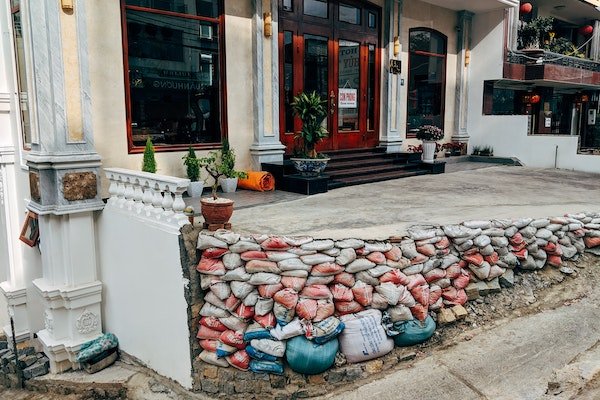
- Repair drain pipes immediately
- Clear street and storm drains
- Clean your roof and gutters
- Get your drains professionally inspected and cleaned by a plumber
- Install a sump pump
- Improve your outdoor drainage system
- Add landscaping to prevent flooding
Before heavy rains, tropical storms and hurricanes hit, prepare your property with imperative flood prevention systems and steps. Even when the skies have cleared again, homeowners will need to forge ahead with effective steps on how to recover from flood damage.
Flood Prevention Systems Are Imperative in Heavy Rain Areas
Flooding damage, hurricane winds and heavy repetitive rains pummel Gulf States like Florida, Texas, Louisiana, Mississippi and Alabama every year. Even nearby states like Tennessee that have some distance from the coasts must deal with the impact of these heavy rains. Nashville alone had its third wettest year in the city’s history last year in 2019 – right behind the years 1979 and 1880.1
Water can wreak havoc on your pipes, sewers, yards, basements, and building foundation. That is why it is important to keep an eye on your plumbing when experiencing heavy rainfall, especially if that heavy storm system spans several days (or weeks) in a row.
Implement These 7 Prevention of Flood Methods for Your Property
There are a handful of proven flood prevention tips that can help avoid more serious and messier plumbing issues or flooding when the storms arrive.
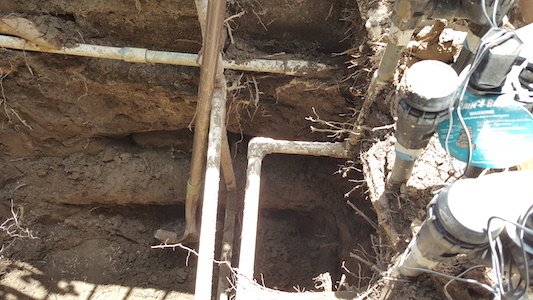
1. Fix Cracked Drain Pipes Right Away
A common problem that must be resolved before heavy rains arrive are pipes with cracks that may be compromised. Old or damaged pipes are in danger of bursting when rainwater builds up and pressure elevates. This allows contamination to enter your bathing and drinking water. Pay attention to any changes in the color, taste and smell of your water, all possible indicators of a pipe crack or burst.
2. Clear Your Storm Drains
Your storm drains help avoid floods by allowing water from heavy rains and ground water to clear. When these are blocked, you’ll begin to notice a quickly growing pool of water and debris like sticks, leaves, soil and anything else that floats! Fail to pay attention to it and it can overtake your entire yard and enter your property.
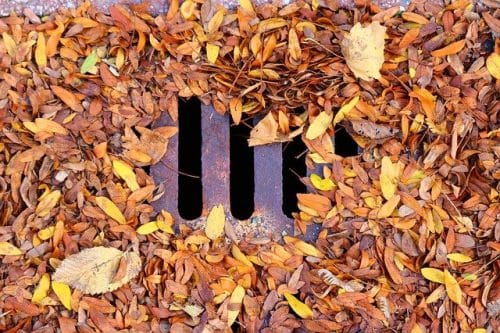
Consider these Do It Yourself drain clearing options:
- Clear Away Debris – Make sure the drain opening is not covered with leaves or dirt. Clear them far enough away so they don’t repeat the issue.
- Boiling Water – If water buildup does not yet exist, try flushing your drain by pouring boiling water down into it to loosen any oils, soaps or fats that may contribute to a blockage.
- Try a plunger, drain snake or auger – A plunger may free some debris, but if you’re dealing with a mud and soil blockage, and are experienced with using an auger or snake, it might clear the drain. It’s important to note that certain tools should be paired with the corresponding piping. To avoid damage, pay attention to manufacturer instructions when clearing PVC, corrugated or perforated piping.
- Avoid the use of harsh chemicals – The majority of professional plumbers do not recommend the use of chemicals when clearing your storm drain.
- Call a plumber – A plumbing sewer specialist will be able to utilize equipment like a sewer cleaning machine or hydro jetting to remove the blockage and get your storm drain clearing water again.
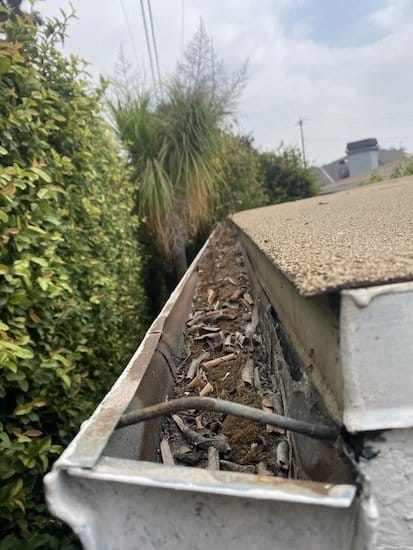
3. Clean Your Roof Drainage System
Leaves and sticks tend to gather and when combined with rainwater, they are the leading culprit of clogged drains and pipes. If you haven’t peeked at your roof gutters for a while, don’t be surprised if they are completely full with dirt and leaves. Left for long enough you’ll find moss buildup and a mini-ecosystem springing to life. All of this of course blocks the designed escape route of water you want to channel to your storm drains.
4. Get a Plumbing Inspection and Professional Drain Cleaning
Annual plumbing inspections are recommended to make sure your pipes, drains, and sewer system are in good working order before there is a problem. This applies to home purchases as well. Get peace of mind for that big purchase made on a sunny day with confidence it will hold up when the rains arrive. A plumbing inspection will test these systems and identify issues.
When a plumbing inspection has identified a slow or blocked drain (or you already know you have one), address it immediately so the problem doesn’t escalate with heavy storms.
5. Install a Sump Pump on Your Property
Sump pumps are the devices that keep your home (especially basements) dry and free of excess water. A sump pump, typically housed in a pit, will automatically detect rising water levels and then push the water out and away from your property through a discharge line. There three main types of sump pumps to consider that each have their merits:
- Submersible
- Pedestal
- Water Powered
6. Improve Your Outdoor Drainage System
Low points on your property lead to standing water and ultimately can lead to flooding and damage to your pipes and sewer system. Proper drainage is essential for your yard.
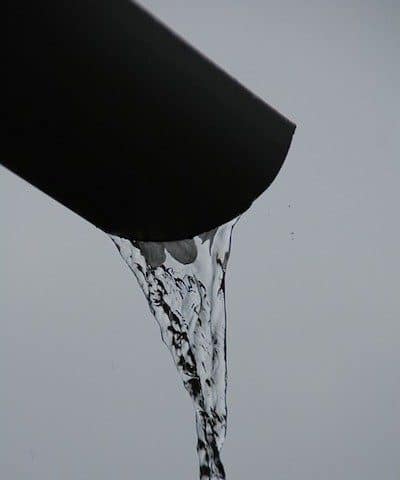
Some popular methods include:
- Extend the downspout: Extend the length of your downspout that comes down from the roof and usually dumps out inches from the property. By redirecting the water flow from low lying areas, you can channel that water accumulation to an area that already has good efficient drainage.
- Add an Underground Pipe: If you’re pretty handy, you might want to add an underground drainage system that involves digging a gradually downward sloping trench. A buried PVC pipe connected to a catch basin that collects water is a fairly straightforward way to channel water away from the home.
- French Drain Installation: These drain systems use piping with perforations in them and allow the collection of water to be dispersed throughout the soil in your yard. Best part is they do not require an outlet.
7. Add Landscaping To Prevent Flooding
Changing the design of your yard can create the added benefit of improved drainage that becomes essential with heavy rains.
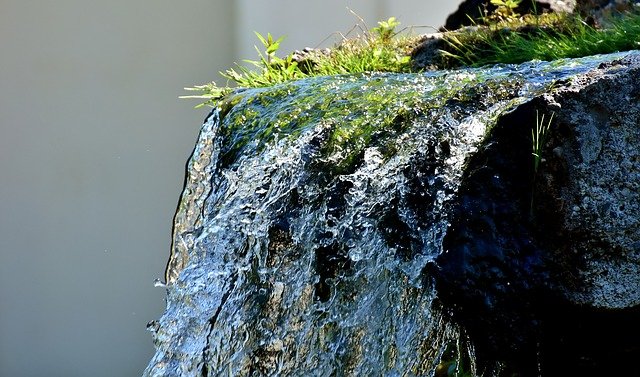
Here are some popular landscaping improvements to prevent flooding:
- Build a Dry Creek Bed – These are small trenches or “arroyos” that you’d dig to slope downward on your property. Then the landscaping design fun begins as you fill the space all sizes, shapes and styles of boulders and stones. It adds some game to your property while also challenging heavy rains downstream and off property and can simultaneously be diverted into soil targeted for plantlife.
- Construct a Rain Garden – The technical goal here is to create a basin filled with plant life that directly benefits from rainwater run-off from your roof or areas on higher ground. This is considered by many to be a meaningful project of creating an attractively designed plant-filled landscape with the added bonus of boosting your flood prevention plan.
- Install a Stormwater Drainage Well – Known sometimes as “dry wells” or “bored wells,” these drainage systems are holes that are dug in the ground, filled with gravel and similar materials and they catch and hold rainwater as it seeps slowly into the ground. These are pretty straightforward to install for both residential and business properties and offer another layer of flood protection.
How to Recover from Flood Damages
After the rains have passed, you’ll no doubt be checking for damage, flooding and other problems. It’s important to spend time drying out your property, a step helped with the use of a dehumidifier. You may need to call in the pros to restore your gas and electrical utilities. Always use caution when dealing with flooded units like water heaters that probably will need to be cleaned along with the rest of the property before additional use.
Beware of these warning signs of a plumbing problem after a storm:
- Water leaks
- Standing water in the basement or crawl space
- Overflowing drains
- Sink water that is colored or tastes like copper
- Mildew smell permeating the house
Flood Proof Your Home Before The Next Storm
The most challenging (and most common) time homeowners dive into flood proofing their homes is after the damage has occurred, especially if you’re dealing with the aftermath of a hurricane or tropical storm. That’s when contractors and plumbers are most needed.
Just remember that as you implement any of the 7 flood prevention tips above, you may be required to obtain a building permit and follow local building codes. Done correctly, it can add the protection you need while adding beauty and value to your property.
Common FAQs About Flood Prevention Methods
Yes. The most common problems with rain and plumbing are:
- Increased pressure on buried pipes can cause them to bend and crack
- Shifting underground pipes can lead to cracked pipes
- Cracked pipes
- Pipe, drain, and sewer backups
- Clogged storm drains
- Water leaks
- Standing water in basements and crawl spaces
Yes. Times of heavy rain keep plumbers busy fixing pipes, sewer lines, and sump pumps.
Yes, particularly in the case of septic tanks. Heavy rain can overwhelm the septic tank and flood the drain field, and cause the sump pump to malfunction. When this happens, you may notice standing water in your yard, basement, or crawl space.
Yes. As heavy rains fall, the ground around pipes softens and shifts. This shift can cause the buried pipes around to move or bend from their original position and crack. Debris (dirt/mud, leaves, rocks, etc.) and tree roots can then make their way into the cracks and lead to clogged pipes and backups in sinks, tubs, showers, and basements.
The U.S. Environmental Protection Agency (EPA) emphatically answers this question:
No! At best, pumping the tank is only a temporary solution. Under worst conditions, pumping it out could cause the tank to try to float out of the ground and may damage the inlet and outlet pipes. The best solution is to plug all drains in the basement and drastically reduce water use in the house.
The EPA has a detailed list of recommendations that includes these important do’s and don’ts:
- Don’t drink well water until it is tested and approved.
- “Do not use the sewage system until water in the soil absorption field is lower than the water level around the house.”
- Have a professional inspect and service or clean your septic tank, especially if you think it was damaged in the flood.
- Pump the septic system (tank and lift station) ASAP after a flood.
Additional Resources:
- Preparing for a Flood – Essential planning from ready.gov
- Protecting Building Utilities from Flood Damage – from the Federal Emergency Management Agency (FEMA)
- Septic Tanks and Flooding – US Environmental Protection Agency (EPA)
- Understanding Flood Insurance – FEMA
Need help recovering from the storm? Call on the team at Hoffmann Brothers today at 615-515-3015.
1. [https://fox17.com/news/local/2019-marks-4th-wettest-on-record-for-nashville]↩


